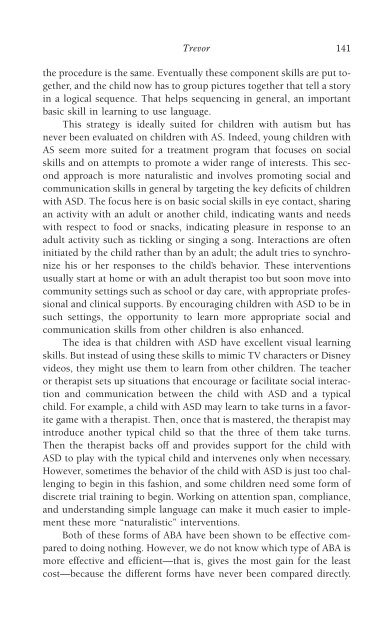978-1572305441
autism
autism
You also want an ePaper? Increase the reach of your titles
YUMPU automatically turns print PDFs into web optimized ePapers that Google loves.
Trevor 141<br />
the procedure is the same. Eventually these component skills are put together,<br />
and the child now has to group pictures together that tell a story<br />
in a logical sequence. That helps sequencing in general, an important<br />
basic skill in learning to use language.<br />
This strategy is ideally suited for children with autism but has<br />
never been evaluated on children with AS. Indeed, young children with<br />
AS seem more suited for a treatment program that focuses on social<br />
skills and on attempts to promote a wider range of interests. This second<br />
approach is more naturalistic and involves promoting social and<br />
communication skills in general by targeting the key deficits of children<br />
with ASD. The focus here is on basic social skills in eye contact, sharing<br />
an activity with an adult or another child, indicating wants and needs<br />
with respect to food or snacks, indicating pleasure in response to an<br />
adult activity such as tickling or singing a song. Interactions are often<br />
initiated by the child rather than by an adult; the adult tries to synchronize<br />
his or her responses to the child’s behavior. These interventions<br />
usually start at home or with an adult therapist too but soon move into<br />
community settings such as school or day care, with appropriate professional<br />
and clinical supports. By encouraging children with ASD to be in<br />
such settings, the opportunity to learn more appropriate social and<br />
communication skills from other children is also enhanced.<br />
The idea is that children with ASD have excellent visual learning<br />
skills. But instead of using these skills to mimic TV characters or Disney<br />
videos, they might use them to learn from other children. The teacher<br />
or therapist sets up situations that encourage or facilitate social interaction<br />
and communication between the child with ASD and a typical<br />
child. For example, a child with ASD may learn to take turns in a favorite<br />
game with a therapist. Then, once that is mastered, the therapist may<br />
introduce another typical child so that the three of them take turns.<br />
Then the therapist backs off and provides support for the child with<br />
ASD to play with the typical child and intervenes only when necessary.<br />
However, sometimes the behavior of the child with ASD is just too challenging<br />
to begin in this fashion, and some children need some form of<br />
discrete trial training to begin. Working on attention span, compliance,<br />
and understanding simple language can make it much easier to implement<br />
these more “naturalistic” interventions.<br />
Both of these forms of ABA have been shown to be effective compared<br />
to doing nothing. However, we do not know which type of ABA is<br />
more effective and efficient—that is, gives the most gain for the least<br />
cost—because the different forms have never been compared directly.



